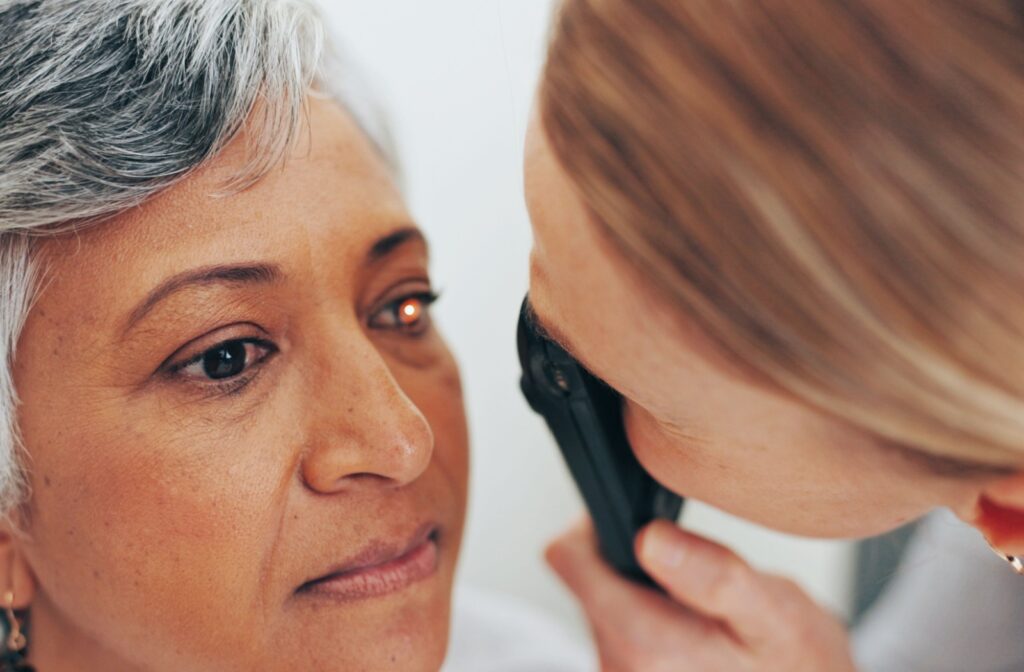Your eyes can reveal more about your health than you might think. During an eye exam, optometrists can spot early signs of diabetes—sometimes before other symptoms appear. Swelling, bleeding, or abnormal blood vessel growth may signal diabetes-related complications.
Regular eye exams do more than assess eyesight—a thorough eye exam can provide insight into overall health, making routine exams a valuable tool for early detection and proactive care.
How Diabetes Shows Up in Your Eyes
Diabetes can leave visible markers in the eyes, often even before other symptoms appear. During an exam, optometrists look for changes in the blood vessels, which may indicate the effects of high blood sugar on circulation and blood vessel growth.
Bleeding or fluid leakage in the retina can suggest weakened blood vessels. Blurred vision may occur due to macular swelling. Abnormal blood vessel growth can signal diabetic retinopathy.
Since these changes often develop before other symptoms, regular eye exams are key in detecting potential concerns early.
The Impact of Diabetes on Eye Health
If diabetes is not effectively managed, it can lead to several vision-threatening conditions. Over time, high blood sugar can damage blood vessels in the eyes, contributing to serious complications:
- Diabetic retinopathy causes damage to the retinal blood vessels, resulting in blurry vision & floaters
- Diabetic macular edema leads to swelling in the macula, affecting central vision
- Poor blood flow & oxidative stress double the risk of glaucoma, a group of diseases that damage the optic nerve & can result in irreversible vision loss
- High blood sugar levels can cause structural changes in the eye’s lens, leading to progressive cataracts, which result in cloudy vision & reduced clarity
These conditions may develop gradually, making routine exams essential for tracking changes.

What to Expect During an Eye Exam
Optometrists use various tests to assess vision, detect early signs of disease, and monitor changes over time:
- A visual acuity test measures your ability to focus at different distances
- Tonometry checks internal eye pressure to help identify risks for glaucoma
- A dilated eye exam involves eye drops to enlarge the pupils for a closer look at the retina & optic nerve
- Retinal imaging captures high-resolution images of the back of the eye, helping your eye doctor monitor potential health issues
Surprising Clues About Your Health Detected from an Eye Exam
The eyes provide a detailed glimpse into your overall health. Comprehensive eye exams can reveal early signs of chronic and systemic conditions that might not yet cause noticeable symptoms. There are many conditions your eye doctor can detect:
- Circulation changes & damaged blood vessels in the retina can show signs of high blood pressure, vascular disease, heart disease, high cholesterol, & stroke
- Swelling or inflammation in the eyes may suggest autoimmune diseases such as lupus, rheumatoid arthritis, or sarcoidosis
Because these indicators often develop before symptoms are experienced, routine eye exams can often offer valuable insight into broader health concerns.
How Retinal Imaging Helps Spot Diabetes Early
Retinal imaging has transformed how optometrists detect diabetes-related eye changes. It’s a noninvasive technology that captures high-resolution images of the retina, optic nerve, and blood vessels at the back of the eye, making it easier to track small yet significant changes over time.
Early signs of diabetic retinopathy, such as tiny blood vessel abnormalities, can be challenging to detect without detailed imaging. Regular imaging allows your eye doctor to monitor retinal health and identify potential issues earlier than traditional exams.
Routine imaging also creates a record that helps track subtle changes from one appointment to the next.
Modern Technology for Proactive Eye Health Care
Innovations in eye care have improved early detection of conditions that affect vision. One progressive tool is optomap imaging, which provides a wide-field view of the retina in a single scan.
Traditional retinal scans capture a 45-degree angle in one scan. However, optomap can capture a 200-degree, high-resolution image in a single scan, including details showing the retina’s central, mid, and outer regions.
Capturing more of the eye in greater detail supports earlier detection of diabetic retinopathy, glaucoma, macular degeneration, and retinal conditions, providing optometrists with a broader view of eye health without requiring dilation in many cases.
When & How Often to Get an Eye Exam
Routine eye exams help you proactively protect your vision and overall health. The recommended frequency depends on age, medical history, and risk factors:
- Infants (0–2) should have an exam between 6–12 months
- Preschool kids (3–5) should have at least one eye exam
- School-aged kids (6–17) should have yearly eye exams
- Adults (18–64) should schedule regular eye exams, at least every 2 years
- Seniors (65+) should have annual eye exams
Individuals with diabetes, eye diseases, or those at risk of eye disease should schedule more frequent eye exams as recommended by their eye doctor. The American Diabetes Association encourages people with diabetes to have yearly diabetic eye exams.
Any sudden vision changes, such as blurriness, flashes of light, or discomfort, should prompt an immediate appointment with an optometrist.
Book Your Eye Exam Today
If you can’t remember your last comprehensive eye exam, now’s a great time to schedule one. At Precision Eye Care in Vancouver, we’re here to welcome new patients and support your family’s eye health.
With a warm, patient-focused approach, we help you maintain clear vision and overall well-being for years to come. Book your appointment today and experience personalized, holistic eye care.





